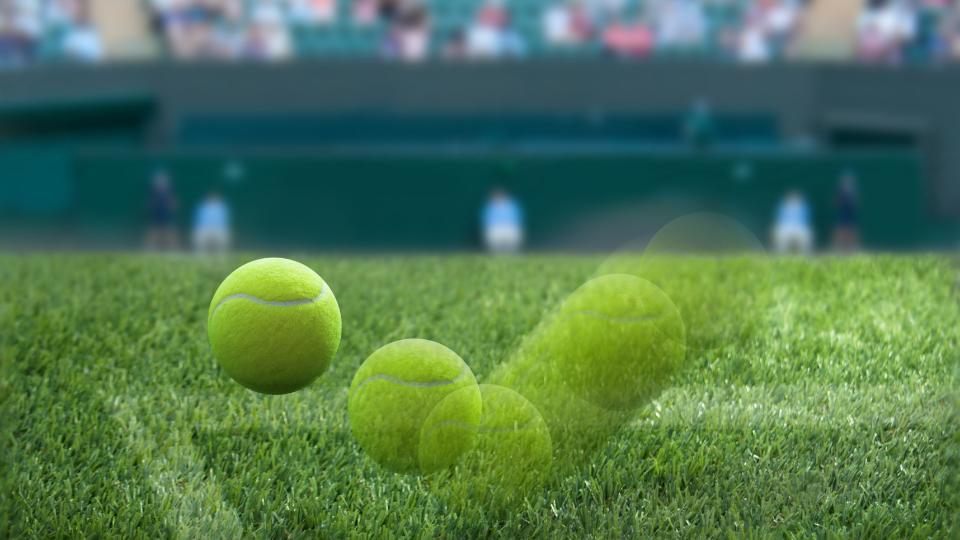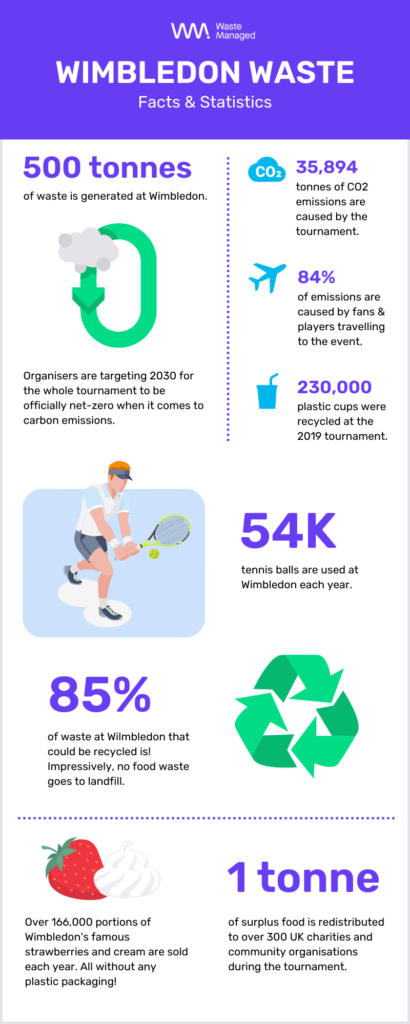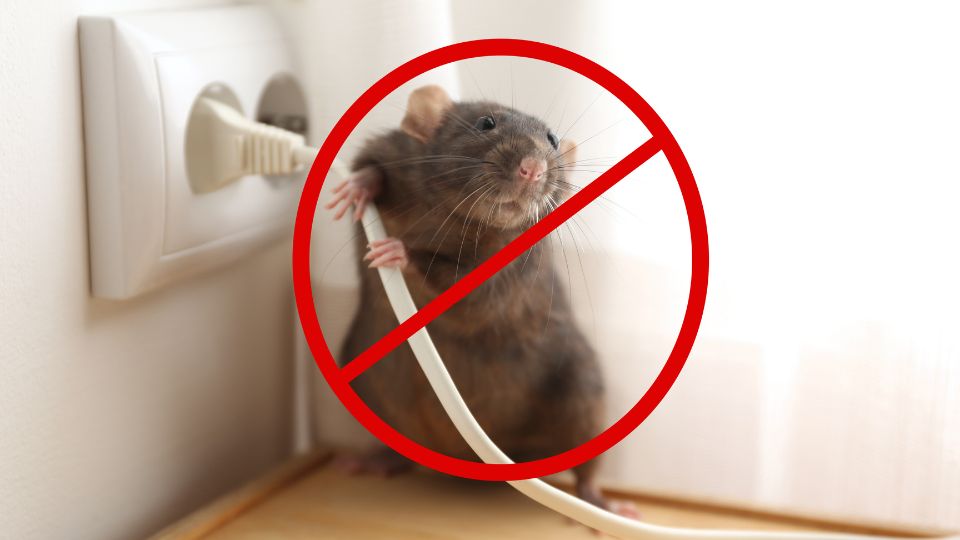
Wimbledon, the prestigious tennis tournament known for its rich history, breathtaking matches, and legendary players, is an event that captures the attention of millions around the world.
However, behind the scenes of this grand spectacle lies an issue that requires our attention: litter and waste management.
In this post, we dive into the world of waste at Wimbledon, exploring interesting facts and statistics that shed light on the impact of this global sporting event on the environment.
The Wimbledon Waste Experience
Wimbledon attracts a massive crowd, with over 500,000 spectators expected to attend this year’s tournament – starting on the 1st July 2024.
As people converge on the grounds, the volume of waste generated increases significantly.
From plastic bottles and food containers to discarded programs and promotional materials, this surge in waste poses a considerable challenge for organisers.
This has prompted The All England Lawn Tennis Club (AELTC), responsible for organising Wimbledon, to set out a comprehensive ten-year sustainability plan for the championship in 2020.
AELTC said that they aim “to act as a force for good, delivering a positive and sustainable impact on our economy, society and the environment in support of the UN’s Sustainable Development Goals.”

Wimbledon Waste Facts and Statistics 2023
- Wimbledon generates a significant amount of waste each year, with estimates suggesting it surpasses 500 tonnes during the tournament.
- Wimbledon’s carbon footprint is 35,894 tonnes of CO2e – the same amount 143,600 Brits emit over a fortnight.
- 84% of emissions come from fans travelling to the tournament
- Organisers are targeting its direct emissions to be net-zero by 2030
- Wimbledon has implemented measures to reduce food waste, with approximately 1,000 kilograms of surplus food being redistributed to local charities during the tournament.
- Approximately 54,000 tennis balls are used during the Wimbledon tournament. After the event, many of these balls are repurposed or donated to clubs, schools, and charities.
- Wimbledon strives for a high recycling rate. In recent years, it has achieved a recycling rate of around 85%
- Wimbledon conducts waste audits to assess and analyse the types and quantities of waste generated, allowing them to identify areas for improvement and implement targeted waste reduction strategies.
- In 2019, Wimbledon successfully recycled approximately 230,000 plastic cups used during the tournament.
- From 2018 to this year’s 2023 tournament, Wimbledon has eliminated nearly 540,000 plastic bottles from the event by promoting the use of refillable bottles and water fountains.
Wimbledon Aces Food Waste
Here are the colossal amounts of food and drink ‘served‘ at the 13-day tennis tournament:
- 320,000 glasses of Pimms
- 190,000 sandwiches
- 166,000 portions of strawberries and cream
- 110,000 scones
- 75,000 ice creams
- 32,000 portions of fish and chips
- 28,000 bottles of champagne
- 25,000 pizzas
But, unfortunately, with all this food comes leftovers and waste.
The exact amount is difficult to know, however.
What we do know is that Wimbledon has served up a winning partnership with City Harvest, a food redistribution platform.
Collaborating with over 300 organisations in the UK, they ensure that in-date food leftovers from the tournament find their way to charities and community organisations.
This partnership has contributed to approximately 1,000 kilograms of surplus food being redistributed.
Furthermore, and rather impressively, no food waste from Wimbledon is sent to landfill and is instead either given to charities or anaerobically digested to create biogas and fertiliser.
This is all part of the tournament’s zero-waste-to-landfill policy, which they have achieved every year since 2018 – excluding the abandoned 2020 event, cancelled due to COVID-19.

Smashing Plastic Packaging
It used to be that the majority of these foods and drinks were packaged in plastic.
However, in recent years, Wimbledon has made great strides in cutting out single-use plastic altogether!
Here are some examples of how they’ve backhanded plastic:
- Recyclable Coffee Cups: For the early risers or those trying to stay awake through a mammoth five-set thriller, the 330,000 coffee cups used each year are also recyclable, contributing to waste reduction efforts.
- Banning Plastic Straws: Plastic straws have been completely eliminated from all areas of Wimbledon, promoting more sustainable alternatives for beverage consumption.
- Farewell to Plastic Liners: In 2021, Wimbledon got rid of plastic liners for food trays for the first time, taking a significant step towards reducing plastic waste and advancing its sustainability goals.
- Embracing Reusable Cups: Wimbledon opts for reusable, rigid plastic cups for serving cold drinks instead of disposables. Fans should return them to dedicated points for washing, ensuring they can be reused.
- Plastic-Free Packaging for Strawberries and Cream: Strawberries and cream are served in plastic-free cardboard boxes at Wimbledon. These boxes are completely recyclable, made using 100% certified cards, and contribute to a circular economy.
Game, Set, Recycle – Wimbledon’s Recycling Initiatives
In 2021, a fantastic scheme created by Hubbub called ‘Wimbledon #InTheLoop’ aimed to introduce a new system for recycling on the go at Wimbledon Championships and for local residents all year round.
Their bins are colourfully designed to draw attention to what waste can be recycled so that consumers can make informed and better decisions about how they discard their rubbish.
This initiative proved to be very successful with:
- 50 new bins introduced
- 900,000 people reached through wide-reaching communications campaign
- A 277% increase in the number of plastic and bottles and cans collected
- 88,000 bottles and cans (estimated) collected for recycling in the initial four months of the campaign
- Now, nearly 9 in 10 plastic bottles and cans disposed of on Wimbledon high street are collected for recycling, compared to 1 in 2 pre-campaign
Sustainable Transport
In 2023, Wimbledon is making a big effort encouraging visitors and staff to use sustainable transportation options, such as public transport, cycling, or carpooling, to minimise the carbon footprint associated with travel to and from the event.
That’s because a whopping 84% of emissions caused by the event come from fans travelling to the tournament!
Most of these emissions are from flights all across the world making their way to London.
To combat this, however, the AELTC are off-setting their carbon emissions by investing in various ‘green’ projects.
In fact, Wimbledon is doing a lot better at reducing its carbon footprint than other similar racket sports like Padel whose World Padel Tour is notoriously carbon-heavy.

Wimbledon Waste Wrapped Up
While Wimbledon is renowned for its captivating tennis matches, it also acknowledges the importance of environmental sustainability.
By implementing effective waste management initiatives and embracing sustainable practices, the tournament sets an example for other global events to follow.
The battle against litter and emissions at Wimbledon is ongoing, but the progress made thus far demonstrates that with dedication and collective efforts, we can preserve the magic of this cherished sporting event while safeguarding our planet for future generations.







